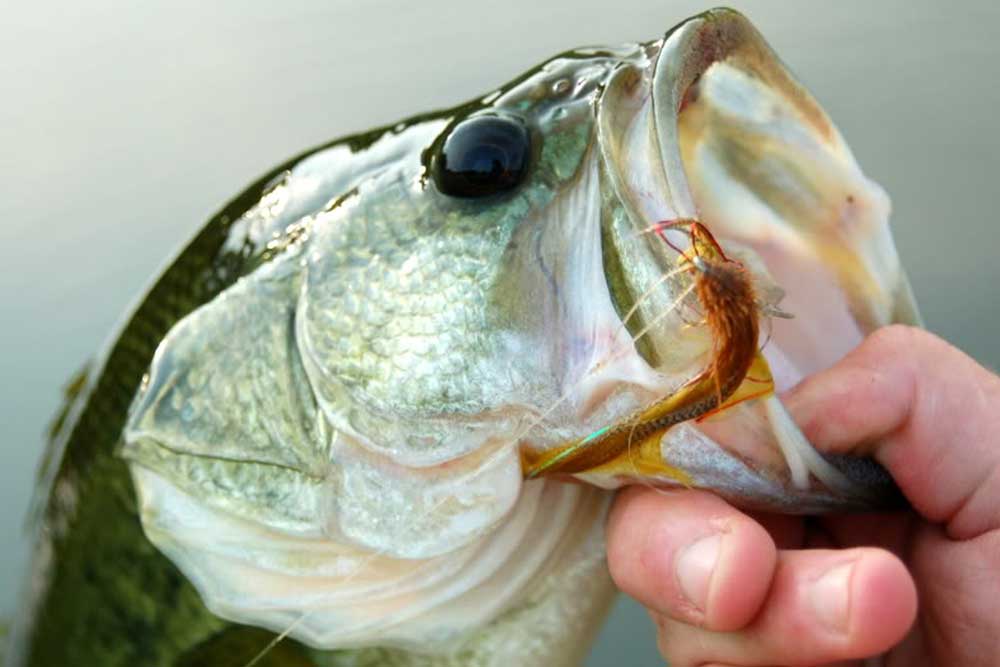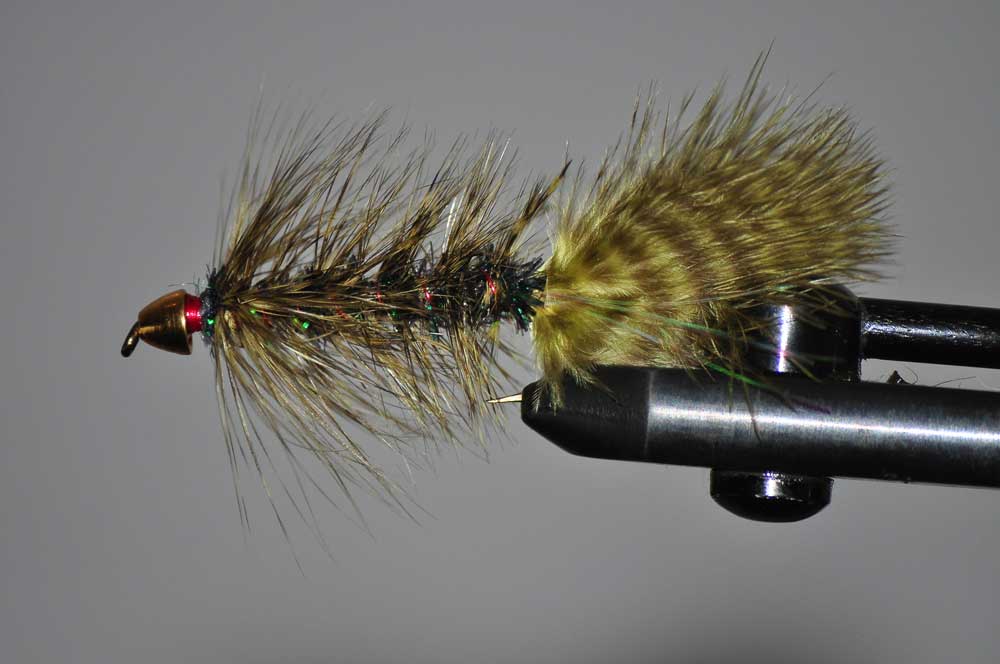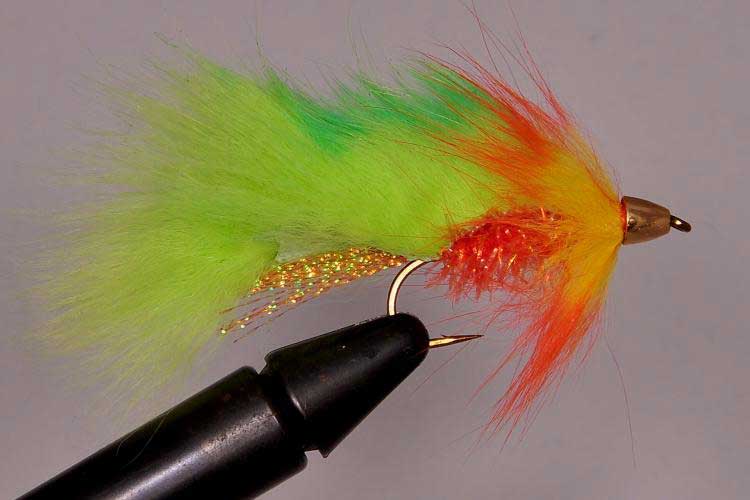In my early days of my fly fishing career, wild trout was my primary target species. I couldn’t get to a trout stream nearly as often as I wanted, because it would require parental supervision. But I was lucky enough to grow up with a family pond, filled with bass and sunfish. I would spend hours with my 7’6” five-weight, casting dry flies, nymphs, and streamers. I mostly caught sunfish, but occasionally hooked into a bass and experienced quite a fight on that light rod – which got me thoroughly hooked on fly fishing for bass.

There is no wondering why largemouth bass are the most popular gamefish in the United States. They are plentiful throughout the country, and even in smaller sizes, put up a great fight. Mighty headshakes, dogged dives toward cover, and acrobatic leaps make bass one of the most exciting freshwater fish to catch. Add the flexible light action of a fly rod to the equation, and the excitement increases exponentially. Sometimes fly fishing can also be more productive than fishing other lures or baits. When in a place that sees a lot of angling pressure, you can give the fish a different look than what they’re used to seeing and get them to bite out of sheer curiosity. Whatever the cases, fly fishing for bass is just plain fun. Here's what you need to get started.
Fly Fishing Gear
It is possible to catch bass on a five-weight rod, more often used for trout fishing. However, it’s dubious to try and chuck big bulky flies with a lighter rod. The rod you choose has to be a compromise between the size of flies you wish to cast and also the size of fish you expect to catch. A nine-weight rod will throw most large flies, and even smaller ones. However, if you’re catching bass in the 12- to 15-inch range, you aren’t going to get a terribly exciting fight. The best range for bass fly rods is six- to eight-weights. If you only want to fish for smallies with the rod, a six-weight will stand up to large fish and still allow you that good light tackle fight. If you love throwing Game Changers and other big tandem flies like the Circus Peanut, you might want to invest in an eight-weight. This rod will also allow you to handle other big freshwater predators like pike and muskie, both of which also prefer big flashy flies, as well as stripers, blues, redfish, and even bonefish in saltwater.
A simple floating line to match the rod weight will do just fine. You can lengthen your leader or add weight to help get the fly down in deeper water, to a certain point. If you fish anything deeper than 15 feet, you might want to consider a sinking tip, intermediate, or even full sinking line, though to maintain the versatility of the floating line, I recommend a sink tip that you can attach to your floating line.
In terms of leaders, you do not need to go light. Bass aren’t leader shy the way trout can be and the smallest you need to go is 3X. Thicker leaders are stronger and more abrasion-resistant, which helps if you need to drag a lunker out from under a sunken tree. The length of leader is dependent on the water you’re fishing, but for the most part a seven- to nine-foot leader will do the trick. When fishing with bigger flies, you’ll have better control with a shorter leader.
Tip: though difficult to describe in writing, if you’re planning to throw big flies, go on Youtube and look up the "Chuck and Duck" casting technique, popular with bass, pike, and muskie fly anglers.
Flies For Bass Fishing
Lures for largemouth are often flamboyant, with big, bright teaser skirts, flashy blades, and big sizes. If you are a fly tier, largemouth bass flies give you the opportunity to break out the neon-colored rabbit fur, flashy wing and tail material, and rubber legs. As a general rule for largemouth: big and showy.
As it is with trout, so too it is with bass. Match. The. Hatch. You hear this from fly fisherman everywhere, and it is a fundamental truth in fishing; you will catch more fish if you are able to imitate the prey the fish are focused on eating. Much of this is common sense; if you’re fishing in the cooler months of March and April, you will not see as much action fishing a frog popper on top of the water as you would with a crayfish pattern jigged off the bottom. If you pay attention to the insect life and other habits of the bass's prey, then find a proper imitation for that prey, you will have no problem catching fish.
Here are a few patterns to get you started:
Bass Poppers
The first fly most anglers think of when fly fishing for bass is a popper, and for good reason. They’re easy to see as you pop them on top of the water, and they get results. A fish rarely takes a popper subtly, especially bass, and there are few things as exciting as a fish exploding on a topwater bait. Keep a couple of these in your box in black, white, shades of green, and brown to cover a number of different prey items, including frogs, terrestrial insects, and even mice.
Rabbit Fur
One of my favorite fly materials for bass is rabbit fur. The movement of rabbit fur is fantastic for enticing largemouth bass in shallow water applications. It can be cut into strips for Zonkers, which can be supersized for bass. Use two strips in a rusty brown color to make crayfish claws. It can wrap around the hook shank and make a body that undulates in the water. You can use the strips as a pair of legs and wrap a body to make a quick and easy frog fly that swims just below the surface, kicking like a fleeing frog. If you want to go smaller, like a leach pattern, you can cut the fur to make a tail and also dub it on the hook for the body. If you want to fish one of these flies deep or create a faster jigging action, I recommend using a small bullet weight or tungsten fly tying cone to get them down; rabbit fur sinks very slowly.

Woolly Bugger
This fly is iconic for a very good reason: it catches fish. An infinite number of color and size combinations make the Woolly Bugger a must-have. Black buggers can imitate leaches and hellgrammites; white can imitate shad and other baitfish; brown can imitate crayfish and sculpin; olive green can imitate small bluegill and dragonfly nymphs. The only limit is your imagination.
Nymphs
Though bass are known as top predators, they also go for smaller bugs when they are on offer. Ponds and lakes provide ideal habitat for damsel flies and big, juicy dragonflies. Creeks, streams, and rivers all have various macro invertebrates like hellgrammites (dobsonfly larvae) and stoneflies. When fishing nymphs for bass you will want to upsize your flies; these fish want some meat. A Prince Nymph in a size eight and larger is a great all-around offering for any waters. I normally fish this nymph in a tandem rig, adding a big Hare's Ear nymph in size 10 to 12. Use different beads or even go beadless, depending on the speed you want it to sink.
Where to Go Fly Fishing for Largemouth Bass
The type of water you fish will determine how you fish. Bass in a shallow lake — like one of the mill ponds on the Eastern Shore — will look for cover such as sunken trees, grass, lily pads, and rocks. This type of fishing offers the greatest variety of techniques. Frogs jumped off of logs and popped along the top of the water, salamanders and small baitfish in grasses, crayfish dig holes in mud, and so on. The strikes often come on the transition points where the prey loses the safety of the cover. Cast your fly as close to the cover as you can, then strip it out into the open water increasing the speed once it’s out in the open.
In a deeper lake, look for changes in structure like drop-offs and points. Frequently this is where your fly will resemble a baitfish of some kind (mainly shad) that bass key on in the warmer months and in the fall. Your best bet is to use a Clouser Deep Minnow, Lefty's Deceiver, or other big baitfish fly. Don't have one? Grab one out of your friend's saltwater box. This is where a longer leader, split shot sinkers, or even sinking fly line helps.

In a river or creek, look for ambush points like rocks and debris that deflect the current and offer a place for the fish to hide. Drop your fly into these spots and quickly dart it out to trigger a reaction bite. The fish will not be usually picky in fast-moving water; they don't want to let a meal get away. One of my favorite ways to do this is to use a jig fly, usually a leach or crayfish pattern, with a strike indicator almost at the top of the leader. Pop the indicator hard, which puts a great deal of action into the fly, then let it rest for a second or two allowing the fly to sink back down. If there are fish around, that indicator will charge upstream or into the depths after two or three pops.
If you’re looking to break into fly fishing for the first time, bass are a great place to start. They forgiving of imperfect casts, heavier leaders, and lure choices, which takes out some of the frustration of the learning process. Plus, for many people while a good trout stream may be miles away there’s a lake or a pond close by – and chances are it has plenty of bass.
-By Peter Turcik